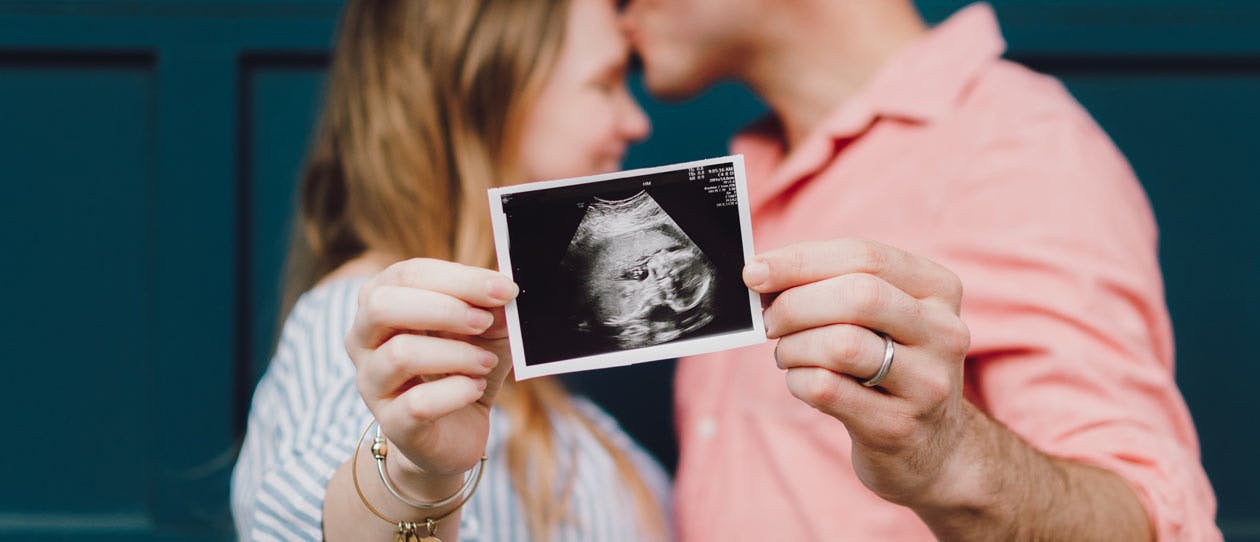Pregnancy typically lasts for 40 weeks and is
grouped into three trimesters. The first trimester runs from week 1-12, the second from week 13-28, and the third from week 29-40.
Your rapidly growing baby is reaching new developmental milestones every week, as you get closer to meeting them. Here’s an overview of how pregnancy unfolds.
1-3 weeks pregnant
In the first two weeks, you technically aren’t pregnant yet – your body is preparing for ovulation. It’s week three when fertilisation occurs, as the egg and sperm unite, forming a one-celled entity called a zygote which travels down the fallopian tube toward your uterus and begins dividing into a cluster of cells.
While you probably don’t know you’re pregnant yet, it’s great to get a head start by taking a preconception supplement if you're planning a pregnancy, to ensure bub has the nutrients it needs.
One month pregnant (weeks 4-7)
By week four, the rapidly dividing ball of cells (called a blastocyst) implants in your uterine lining. It’s during weeks four to seven that most women discover they’re pregnant – breast tenderness, headaches, backaches, nausea or a late period may be your tip-offs.
In week four, baby is tinier than a grain of rice, but by week seven it will be the size of a small blueberry. During this time, bub’s heart starts to beat, the neural tube closes and the major organs and arm and leg buds start developing.
Two months pregnant (weeks 8-12)
Your baby is now officially a foetus, and in this stage will grow from the size of a kidney bean to a lime. By the end of week nine, the inner workings of the ear are complete and genitals have begun to form, and by 10 weeks, the vital organs (the liver, kidneys, intestines, brain and lungs) are fully formed.
From here on, bub’s main mission is to grow bigger and stronger.
Three months pregnant (weeks 13-16)
You’re now in your second trimester and you may notice symptoms such as fatigue and nausea subside. Around week 15, bub will start to hear the sound of your voice and heart, so don’t be shy to talk or sing to them.
Their eyelids start to become sensitive to light and they may be able to sense bright light outside your tummy. Your baby goes from the size of a peapod to an avocado in this phase.
Four months pregnant (weeks 17-20)
During these weeks, bub grows from the size of a pear to a banana. Around 18-20 weeks, you’ll likely get a foetal morphology ultrasound to check baby is developing normally. It’s also likely you’ll start to feel bub move.
By 19 weeks, baby’s hair starts growing and sensory development peaks, with the nerve cells for taste, smell, hearing, sight and touch developing in the brain.
Five months pregnant (weeks 21-24)
You’ve crossed the halfway point of pregnancy now, and baby will go from the length of a carrot to an ear of corn . Bub’s arms and legs are now in proportion and their movements become more coordinated.
Vision, hearing and grip are becoming stronger, and bub may start grasping their umbilical cord. You may notice stretch marks appear on your tummy or breasts –
natural strategies to combat stretch marks include nutrient rich juices and topical vitamin E.
Six months pregnant (weeks 25-29)
Your uterus is now the size of a soccer ball and during this stage, bub grows from the size of a swede to a butternut pumpkin. Your baby will be gaining some fat slowly, and by around week 27-28, will be able to open and close its eyes.
Cognitive development now means that grooves start to develop along the brain’s surface and the amount of brain tissue increases. As you enter the third trimester (week 29), you may begin experiencing
symptoms such as leg cramps, constipation, insomnia and haemorrhoids.
Seven months pregnant (weeks 30-33)
In these weeks, your baby will go from cabbage-sized to weighing almost the same as a pineapple, but you can expect it to gain at least 900 grams more before delivery.
Because things are getting tight in your uterus, baby’s movements may be concentrated in one location, and by week 33, it should be getting ready for delivery by turning upside down. While bub’s skull remains pliable to help the labour process, the rest of their bones are hardening.
Eight months pregnant (weeks 34-38)
Bub’s lungs are nearly fully developed, although their central nervous system still has some maturing to do. By week 35, fingernails have appeared and the kidneys have fully developed.
Size-wise, in these weeks your baby will go from the size of a rockmelon to being as long as a leek and weighing just over 3kg. By the end of week 36, your pregnancy is considered full-term, meaning you could give birth any day – so get that hospital bag packed.
Nine months pregnant (weeks 39-40)
Bub continues to develop a layer of fat underneath the skin, to help them regulate body temperature. As birth draws near, your cervix will soften, shorten and grow thinner as part of a process called ‘ripening’. In these weeks, bub will reach the size of a small pumpkin and weigh in at around 3.3kg.


